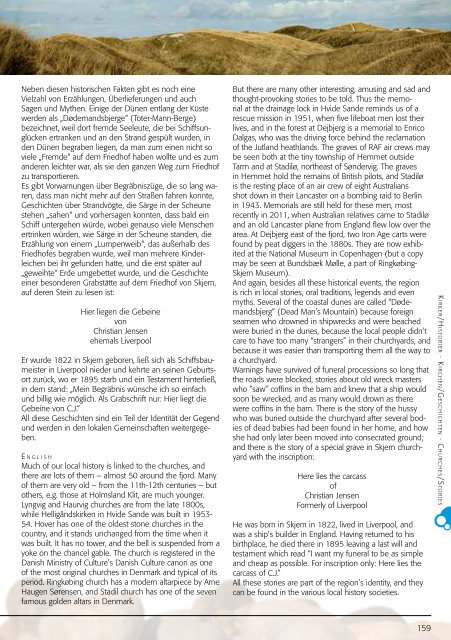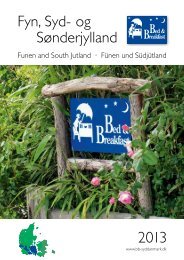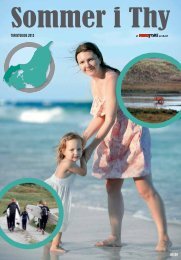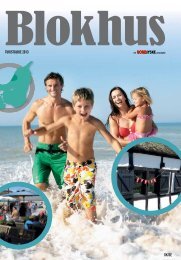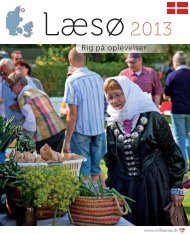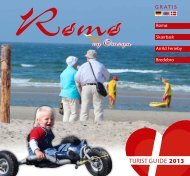Create successful ePaper yourself
Turn your PDF publications into a flip-book with our unique Google optimized e-Paper software.
Neben diesen historischen Fakten gibt es noch eine<br />
Vielzahl von Erzählungen, Überlieferungen und auch<br />
Sagen und Mythen. Einige der Dünen entlang der Küste<br />
werden als „Dødemandsbjerge“ (Toter-Mann-Berge)<br />
bezeichnet, weil dort fremde Seeleute, die bei Schiffsunglücken<br />
ertranken und an den Strand gespült wurden, in<br />
den Dünen begraben liegen, da man zum einen nicht so<br />
viele „Fremde“ auf dem Friedhof haben wollte und es zum<br />
anderen leichter war, als sie den ganzen Weg zum Friedhof<br />
zu transportieren.<br />
Es gibt Vorwarnungen über Begräbniszüge, die so lang waren,<br />
dass man nicht mehr auf den Straßen fahren konnte,<br />
Geschichten über Strandvögte, die Särge in der Scheune<br />
stehen „sahen“ und vorhersagen konnten, dass bald ein<br />
Schiff untergehen würde, wobei genauso viele Menschen<br />
ertrinken würden, wie Särge in der Scheune standen, die<br />
Erzählung von einem „Lumpenweib“, das außerhalb des<br />
Friedhofes begraben wurde, weil man mehrere Kinderleichen<br />
bei ihr gefunden hatte, und die erst später auf<br />
„geweihte“ Erde umgebettet wurde, und die Geschichte<br />
einer besonderen Grabstätte auf dem Friedhof von Skjern,<br />
auf deren Stein zu lesen ist:<br />
Hier liegen die Gebeine<br />
von<br />
Christian Jensen<br />
ehemals Liverpool<br />
Er wurde 1822 in Skjern geboren, ließ sich als Schiffsbaumeister<br />
in Liverpool nieder und kehrte an seinen Geburtsort<br />
zurück, wo er 1895 starb und ein Testament hinterließ,<br />
in dem stand: „Mein Begräbnis wünsche ich so einfach<br />
und billig wie möglich. Als Grabschrift nur: Hier liegt die<br />
Gebeine von C.J.“<br />
All diese Geschichten sind ein Teil der Identität der Gegend<br />
und werden in den lokalen Gemeinschaften weitergegeben.<br />
e n g l i s h<br />
Much of our local history is linked to the churches, and<br />
there are lots of them – almost 50 around the fjord. Many<br />
of them are very old – from the 11th-12th centuries – but<br />
others, e.g. those at Holmsland Klit, are much younger.<br />
Lyngvig and Haurvig churches are from the late 1800s,<br />
while Helligåndskirken in Hvide Sande was built in 1953-<br />
54. Hover has one of the oldest stone churches in the<br />
country, and it stands unchanged from the time when it<br />
was built. It has no tower, and the bell is suspended from a<br />
yoke on the chancel gable. The church is registered in the<br />
Danish Ministry of Culture’s Danish Culture canon as one<br />
of the most original churches in Denmark and typical of its<br />
period. <strong>Ringkøbing</strong> church has a modern altarpiece by Arne<br />
Haugen Sørensen, and Stadil church has one of the seven<br />
famous golden altars in Denmark.<br />
But there are many other interesting, amusing and sad and<br />
thought-provoking stories to be told. Thus the memorial<br />
at the drainage lock in Hvide Sande reminds us of a<br />
rescue mission in 1951, when five lifeboat men lost their<br />
lives, and in the forest at Dejbjerg is a memorial to Enrico<br />
Dalgas, who was the driving force behind the reclamation<br />
of the Jutland heathlands. The graves of RAF air crews may<br />
be seen both at the tiny township of Hemmet outside<br />
Tarm and at Stadilø, northeast of Søndervig. The graves<br />
in Hemmet hold the remains of British pilots, and Stadilø<br />
is the resting place of an air crew of eight Australians<br />
shot down in their Lancaster on a bombing raid to Berlin<br />
in 1943. Memorials are still held for these men, most<br />
recently in 2011, when Australian relatives came to Stadilø<br />
and an old Lancaster plane from England flew low over the<br />
area. At Dejbjerg east of the fjord, two Iron Age carts were<br />
found by peat diggers in the 1880s. They are now exhibited<br />
at the National Museum in Copenhagen (but a copy<br />
may be seen at Bundsbæk Mølle, a part of <strong>Ringkøbing</strong>-<br />
Skjern Museum).<br />
And again, besides all these historical events, the region<br />
is rich in local stories, oral traditions, legends and even<br />
myths. Several of the coastal dunes are called “Dødemandsbjerg”<br />
(Dead Man’s Mountain) because foreign<br />
seamen who drowned in shipwrecks and were beached<br />
were buried in the dunes, because the local people didn’t<br />
care to have too many “strangers” in their churchyards, and<br />
because it was easier than transporting them all the way to<br />
a churchyard.<br />
Warnings have survived of funeral processions so long that<br />
the roads were blocked, stories about old wreck masters<br />
who ”saw” coffins in the barn and knew that a ship would<br />
soon be wrecked, and as many would drown as there<br />
were coffins in the barn. There is the story of the hussy<br />
who was buried outside the churchyard after several bodies<br />
of dead babies had been found in her home, and how<br />
she had only later been moved into consecrated ground;<br />
and there is the story of a special grave in Skjern churchyard<br />
with the inscription:<br />
Here lies the carcass<br />
of<br />
Christian Jensen<br />
Formerly of Liverpool<br />
He was born in Skjern in 1822, lived in Liverpool, and<br />
was a ship’s builder in England. Having returned to his<br />
birthplace, he died there in 1895 leaving a last will and<br />
testament which read “I want my funeral to be as simple<br />
and cheap as possible. For inscription only: Here lies the<br />
carcass of C.J.”<br />
All these stories are part of the region’s identity, and they<br />
can be found in the various local history societies.<br />
159<br />
k i r k e r/hi sto r i e r · ki r c h e n/gesc h i c h t e n · ch u r c h e s/sto r i e s


